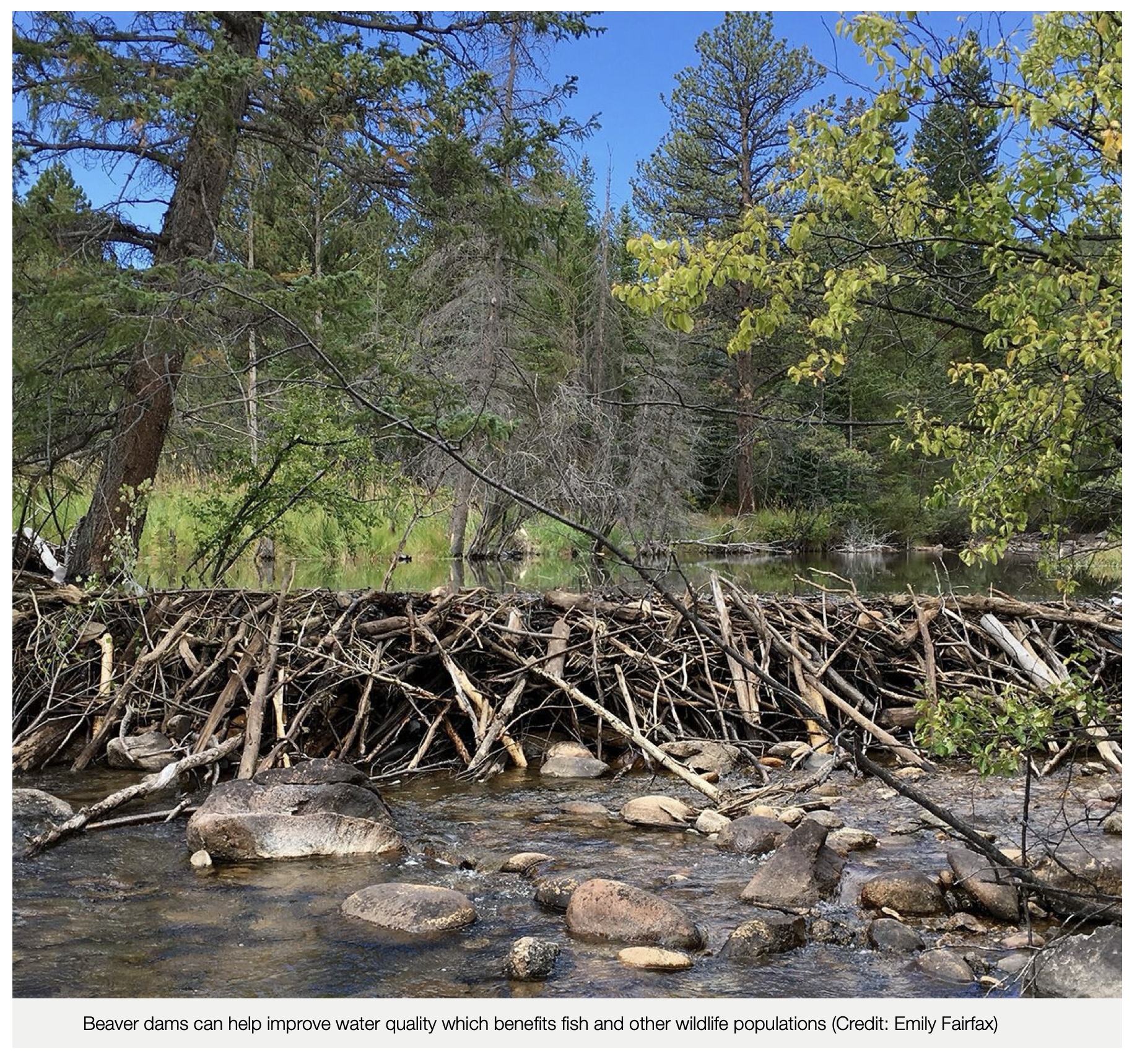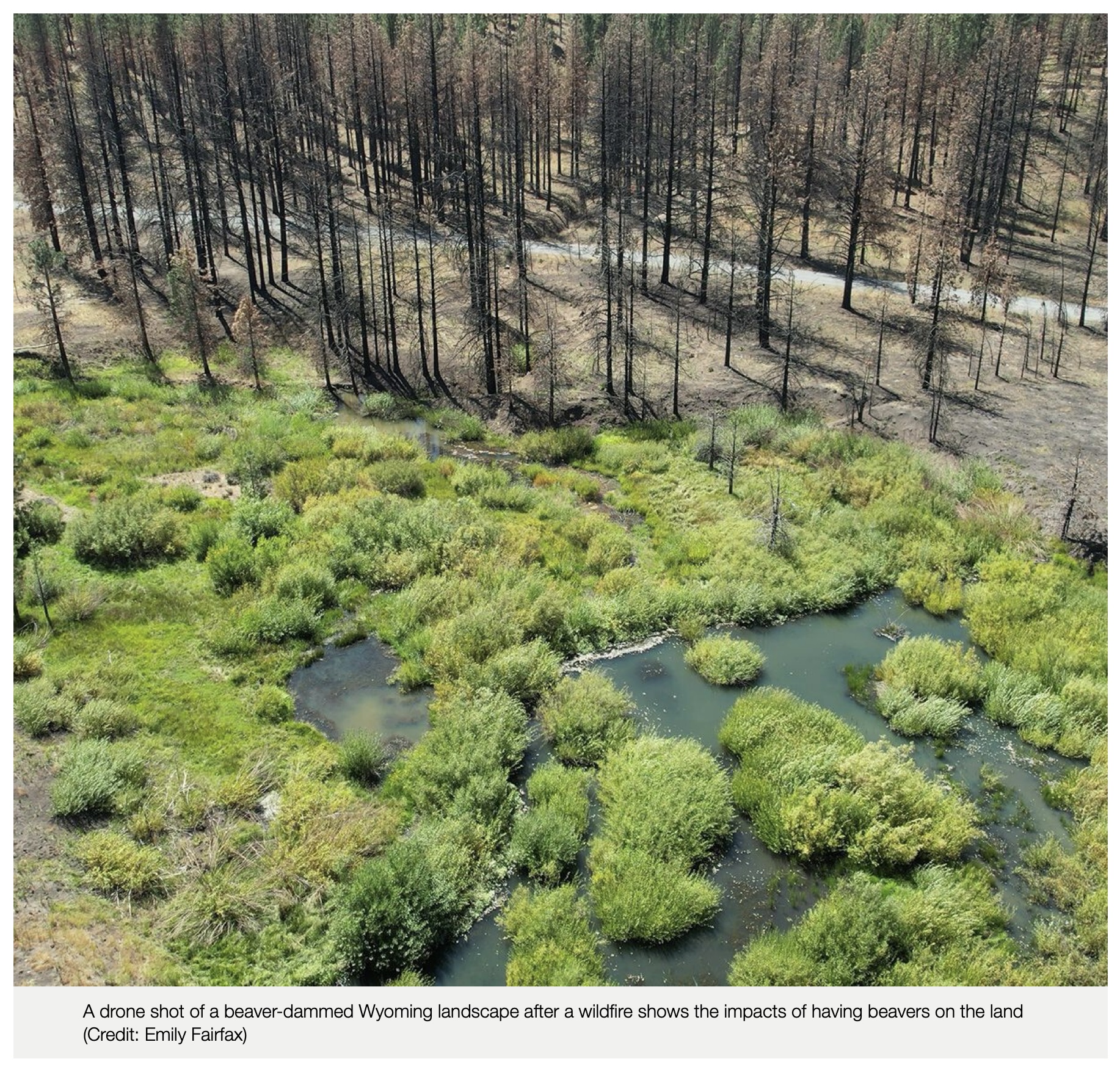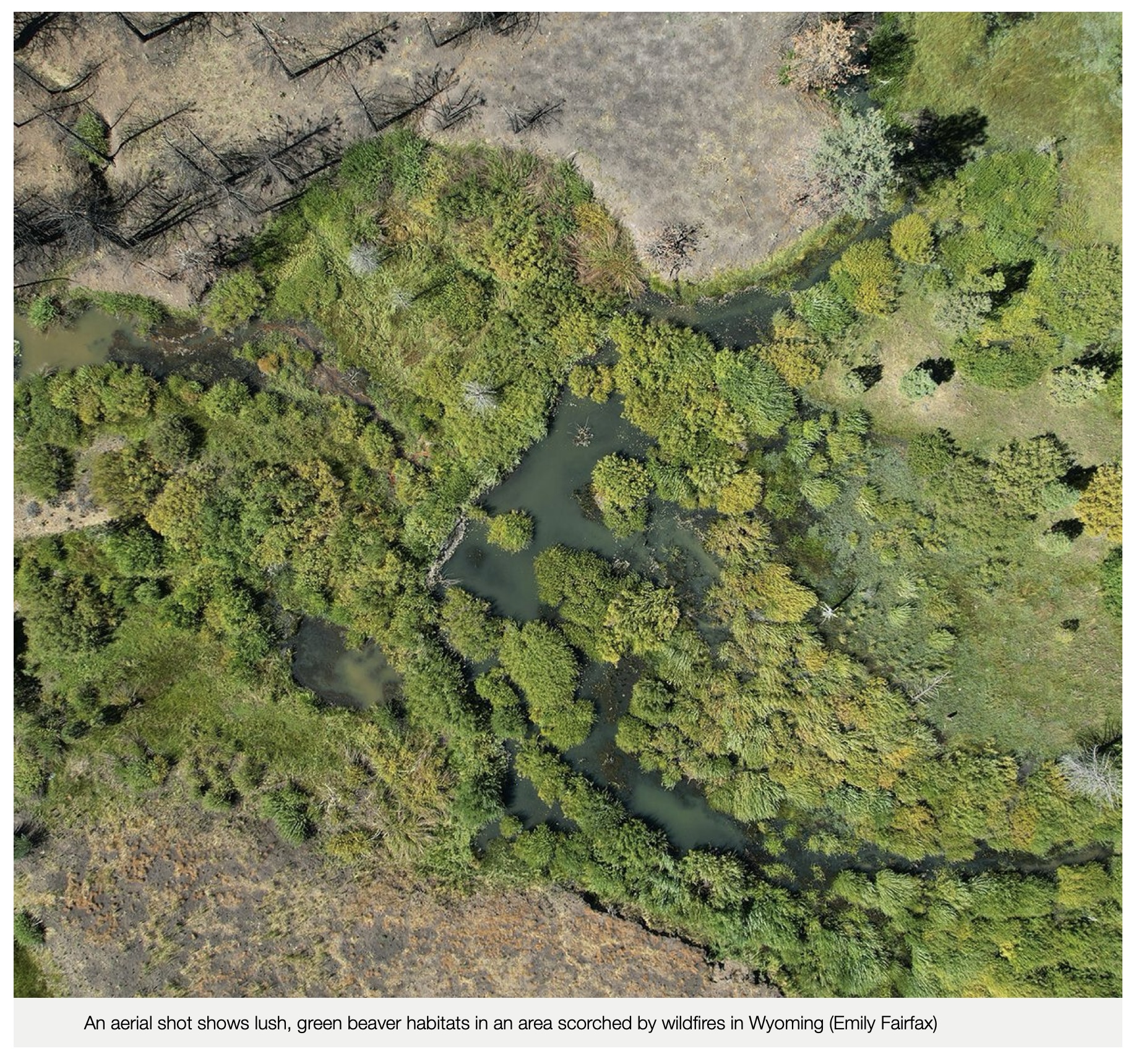Why US Ranchers Are Becoming Beaver Believers

As described in the article blow, the US is bringing back nature’s best firefighters: beavers.
NOTE: this article was originally published to BBC Futures Apple News channel on January 11, 2024. It was written by Lucy Sherriff.
For decades, beavers were considered pests – trapped and shot on sight. Now the attitude towards nature’s best engineers is changing, and farmers are working to bring them back.
Jay Wilde stared at the dry creek on the ranch his family had owned for decades for the umpteenth time that week. He was trying to remember what had changed on the land – when he was a child, Birch Creek would run year-round. Now he was lucky if they got six months’ worth of water. Wilde had been away from his southern Idaho ranch for 30 years, returning to run cattle in 1995. And the cows needed water.
“Without water, it was becoming really hard for me to manage the ranch,” Wilde explains. “I eventually put in a water system for the cows to drink from, but it seemed wrong to me that the stream should be drying up. There’s a lot of life that depends on that water.”
The issue puzzled him for years. In 2006, Wilde was contemplating that dry streambed, wondering what he could do about it. “I had an epiphany,” he laughs. “Suddenly, it dawned on me that when I was growing up we always had beavers in the watershed. And there were no beavers when I came back.
“It got me thinking, beavers had something to do with it,” he says.

A historical hatred
Beavers are vital to ecosystems, as their dam building habits spread water through parched landscapes. This can not only help to regulate the flow of water, it provides another important service – keeping fires under control. Beavers are nature’s firefighters.
Despite their monumental impact on the environment, beavers were almost wiped out in the US during the fur-trapping trade. And the land, like Wilde’s, has suffered greatly due to the decimation of beaver populations. Attitudes that beavers are a nuisance, because of the damage they can cause to human-built structures – such as flooding culverts, the drain pipes that channel water through roadways and other structures, and felling trees – also prevailed long after beaver fur hats went out of fashion. For decades, the animals were trapped, shot, poisoned, and their dams dynamited – all to eradicate the keystone species from their native lands. Landowners simply didn’t want them messing with the ecosystem. Since the battle against beavers began, numbers have shrunk from millions to thousands.
Now, the tide is beginning to shift, and beavers are making a comeback.
“From the 1950s until this year, beavers have been listed as predators in Oregon,” explains Jeff Baldwin, a geography professor at California’s Sonoma University who has published numerous studies on the advantages of recolonising beavers in the American West. “And in Oregon, if an animal is a predator you can kill it.”
A “beaver believer” bill was passed in Oregon in 2023, changing the animals’ status to furbearers, meaning they cannot be killed without a permit. The bill highlighted beavers’ role as a keystone species “that serves as nature’s engineer…[Their] habitat has the ability to provide refugia, stimulate the recovery of other species, and foster resilience on landscapes impacted by climate change”. But, the bill wasn’t popular with everyone – especially farmers.
“[The bill] creates an unnecessary and complicated system of beaver management for private agricultural landowners,” says Lauren Poor, vice president of legal affairs for the Oregon Farm Bureau, an agricultural advocacy organisation. “Our opposition to this needlessly complicated piece of legislation is no reflection on the value beavers play in the ecosystem or the benefits they have on repairing floodplains, however, the great value of beavers to our environment is best suited for public lands, not privately managed agricultural lands.”
Once numbering anywhere from 100 to 200 million, their numbers shrank to as few as 100,000 by the 20th Century, primarily due to the fur trapping trade which erupted during the late 1600s and lasted two centuries. Thanks to public support and awareness, the population has grown to around 15 million.

Even after the demand for their fur dwindled, the killing of beavers continued. “Logging companies hate beavers,” says Baldwin. “Because beavers like to block culverts. So there’s this culture in Oregon, especially in rangelands, of killing a beaver whenever you see it.”
A turning tide
Oregon’s legislative change is indicative of what is unfolding across the American West. For many years, bureaucracy has been a huge hurdle for pro-beaver groups hoping to bring back the animals. But the years of “beaver believer” PR work is paying off.
“There’s been a rapid turnaround and increase in the understanding of the importance of beavers in our ecosystems,” says Peggy Darr, who runs the non-profit Defenders of Wildlife’s Southwest programme, and has been working on beaver reintroductions in New Mexico for the past six years. Darr is talking about the attitude of government agencies, but also says the public’s perception has shifted too. “There are a lot of misconceptions about beavers, but that’s starting to change.” Misconceptions include that beavers eat any kind of tree, when they are actually very picky, and that they compete with farmers for water, when beavers can in fact bring water back into the ecosystem.
“We’ve found that just through opening channels of communication, understanding the rural farming community’s concerns, and showing how we can address the negative things that come with beavers really helps,” says Darr.
Something as simple as installing pond levellers – dubbed “beaver deceivers” – can prevent beaver ponds from flooding houses or other structures, Darr explains. The leveller is a large pipe with a cage around one end that is inserted into a beaver dam. The cage means the beavers can’t plug the pipe up, and so the beaver pond water can’t rise above whatever level the pipe is inserted in at. “A lot of times we saw they came back the next day and started patching all around the pipe,” says Darr. “But no matter how much they patch on the pipe or try to build the dam taller, the water level will stay at the level of the pipe.”
‟ We just have to show people what beavers can do for other wildlife and humans – Peggy Darr
In northern New Mexico, Darr has seen farmers “drastically” change their perception of beavers. “They were pretty hesitant, but they saw first-hand how the beavers provided sustained, reliable water sources throughout the year, even during the hot dry summer we had. To see it is to believe it. We just have to show people what beavers can do for other wildlife, and humans.”
In December 2022, beavers were released into the wild in California for the first time in almost 75 years.
State government-level change, like in Oregon and California, is a great first step, says Baldwin, but the reality is that public attitude towards beavers still needs work. In many states, beavers cannot be relocated, even across private land – and historically landowners have simply killed them. “I’m afraid that on the ground it may not mean as much as we would like,” he says. “There’s a lot of anecdotal evidence of people [in Oregon] just driving by beavers and seeing them and shooting them.”
Ongoing hurdles
There are also mountains of bureaucracy, especially for Native American tribes, for whom the beaver is a culturally significant species.
Reintroducing beavers is something Kenneth McDarment, a member of the Tule River Indian Tribe in California, has been fighting to achieve for years.
After a particularly brutal year of drought in 2014, when the tribe’s drinking water reserves fell to dangerously low levels, the tribe was desperate for a solution. McDarment turned to the tribe’s ancestors for guidance. “I looked to our Tribe’s pictographs, which have a beaver in them for answers to our water issues. From that point on we made friendships and partnered with many people and organisations to find a way to start the process to bring the beaver home to the Tule River.”
McDarment decided to launch a beaver project – to bring back the native species to his ancestral land, and revive the watershed. In 2020, he submitted a grant application to the US Fish and Wildlife Service for beaver and meadow restoration. They were successful, and in 2022, California set aside funds for the state’s Department of Fish and Wildlife to develop a comprehensive beaver management plan. McDarment’s project became the pilot – and future poster child – for beaver reintroduction in California. A date was set – December 2023 – to release the first beavers, but at the last minute, McDarment was told his tribe would not be the pilot project and another location had been picked.
“We were bumped out by a different pilot project and told we would not be getting beavers this year because now it’s too late,” he says. “Once again, the Tule River Tribe is let down. We expect nothing less of the broken promises and treaties…because this is the way that the government has always treated tribes.”
The Department of Fish and Wildlife did not respond to the BBC’s request for comment.
The Klamath Tribes in Oregon have faced similar hurdles, and have instead taken a “build it and they will come” approach. The tribe brought in a river restoration crew to do the work historically done by beavers. The crew has been constructing beaver dam analogues – manmade beaver dams – on several streams to capture sediment and repairing degraded riverbeds to revive riparian vegetarian, which will provide a food source for beavers. “It will take a few years to see a response,” says Mark Buettner, director of the tribes’ water programme, “but we are confident if we create the habitat and food for the beaver they will come back.”

The tribes hope that doing so will eventually boost fish populations, as beavers are known to improve fish habitats, and therefore help threatened fish populations recover. Relocating beavers is the next option – a lengthy process that involves applying for a permit from the state. Signatures from every landowner within four miles (6.4km) of the proposed site must be obtained, testifying that landowners have no objection to the new arrivals.
California’s beaver reintroduction programme is a promising a step in the right direction, though, says Kate Lundquist, director of the Occidental Arts and Ecology Center, the organisation which led the pilot programme. “We’re very hopeful that this is the beginning of a new era of proactive beaver conservation,” she says.
Nature’s engineers
For centuries, Native American tribes understood the importance of having beavers on the land. Not only do the wetland beavers provide a habitat for other animals, such as otters, turtles, and fish, they are also extremely efficient at protecting landscape from wildfires. Beavers create deep ponds by building dams, but they also dig long, thin canals that gradually spread water throughout landscapes. The slow flow of water allows the ground time to absorb it, which both encourages the growth of plants and flourishing of wildlife, but also acts as a firebreak as the ground is wet. In fact beavers are so great at shaping ecosystems, they’re often referred to as nature’s engineers– as well as firefighters.
Ecohydrologist Emily Fairfax studies how water interacts with its surrounding ecosystem. Fairfax examined years of aerial photographs from Western states where major wildfires and droughts had occurred. Amid the black, charred landscape following a destructive wildfire, Fairfax could see vibrant patches of green. Her study found that beaver-dammed riparian corridors are “relatively unaffected” by wildfire compared to other areas without beavers, and the animals play a “significant role” in fire resistance.
“Beavers are a major solution to helping us adapt to future climate change effects,” Darr says. “They’re amazing creatures that can help us a lot if we just learn to live with them.”
‟ We’re very hopeful that this is the beginning of a new era of proactive beaver conservation – Kate Lundquist
Realising how important beavers were to his landscape was the catalyst for Wilde to embark on a two-year-long enterprise to obtain permission from the US Forest Service to bring beavers back to the land. Wilde read everything he could get his hands on to educate himself about beavers. It was a stark change for the rancher, who always considered the animals pests.
“We have to realise the good they can do for us,” Wilde says. In 2008, Wilde was finally given the green light from Idaho’s Fish and Wildlife Office to relocate beavers onto his land (wildlife laws vary from state to state). After several failed efforts to bring in beavers – they don’t always stay, or survive, when they’re relocated – Wilde teamed up with Joe Wheaton, a fluvial geomorphologist at Utah State University, who had decades of river restoration experience. In 2015, the pair built 19 beaver dam analogues to encourage the next group of beavers Wilde brought in to stay. And finally, the plan worked.
“It’s become a poster child of beaver restoration,” Wilde says. “They’ve transformed the habitat.”
In 2019, Wilde counted 170 of the formerly-threatened Bonneville Cutthroat Trout species in a 100m (328 ft) stretch of his creek – compared to five in the early 2000s. And this year, for the first time since Wilde could remember since he was a child, the creek ran all year long.
Changing public attitude is key to beaver resurgence, and Wilde now travels around the US, speaking to anti-beaver ranchers about the successes he has had. Several of his own neighbours have already followed suit.
His next goal? Bringing back fire to his ranch – and Wilde and McDarment, whose tribe has practiced cultural burning for centuries – are swapping notes.
“It just tickles me,” says Wilde, “I couldn’t be more happy with the way it turned out. It’s like a dream come true.”
—
For more posts like this, in your inbox weekly – sign up for the Restoring Diversity Newsletter
“`
